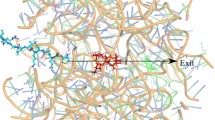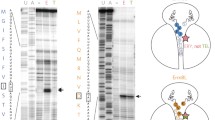Summary
The mRNA sequence in plasmid pE194 encoding the gene responsible for erythromycin resistance has been deduced from the corresponding DNA sequence. The putative control region of this gene located at the 5′ end of the messenger transcribed along with the coding sequence comprises a series of inverted complementary repeat sequences that can redistribute and assume alternative double stranded conformations. Activation of the messenger depends on the degree to which ribosomes inhibited (“stalled”) by erythromycin disrupt the secondary structure in a part of the control region that simultaneously codes for a small peptide and overlaps two of the inverted repeat sequences. In this model, ribosome stall is produced by erythromycin, the inducer, and the result of inverted repeat sequence redistribution is the unmasking of a ribosome binding site for synthesis of the protein that mediates the resistance phenotype. Free energy calculations have been made for the postulated “active” and “inactive” conformations of the control region as well as for 4 classes of mutants that have been mapped in the control region. In addition, calculations have been made for hypothetical sequence alterations corresponding to mutants not yet found. Two modes of induction have been defined and their associated free energy changes calculated; these are (i) preemptive induction, in which ribosome stall resulting in disruption of stem sequence conformation causes one inverted repeat sequence to preempt a second. In the resultant redistribution of complementary inverted repeat sequences, the control region assumes the “active” conformation owing to unmasking of a sequestered ribosome binding site, and (ii) direct dissociation of the critical stem sequences to unmask the sequenstered ribosome binding site, a reaction that bypasses the preemptive association mechanism. The base change found in one of the mutants is consistent with the preemptive mode of induction according to which ribosome stall to an extent that destabilizes the firt three of 13 possible paired bases in the inactive form of the messenger suffices to induce expression of the resistance phenotype. The single-base-change mutations to constitutive expression most commonly found are precisely those that produce the greatest loss of negative free energy; this majority group affects the control region sequence further downstream and appears to act by the direct dissociation mode. Finally, a pair of weakly interacting inverted repeat sequences flanking the more strongly interacting repeats is present; it is postulated that this outer pair serves during the initial phase of induction, as well as later, to turn off expression of the induced messenger after removal of an inductive stimulus. The wide variety of possible mutations capable of disrupting stability of the control region suggests a model to explain the diversity of “partial constitutive” phenotypes found in earlier studies.
Similar content being viewed by others
References
Borer PN, Dengler B, Tinoco I, Uhlenbeck OC (1974) Stability of ribonucleic acid double-stranded helices. J Mol Biol 86:843–853
Horinouchi S, Weisblum B (1980) Posttranscriptional modification of mRNA conformation: Mechanism that regulates erythromycin induced resistance. Proc Natl Acad Sci USA 77:7079–7083
Iordanescu S (1976) Three distinct plasmids orgginating in the same Staphylococcus aureus strain. Arch Roum Pathol Exp Microbiol 35:111–118
Iordanescu S (1977) Relationships between cotransducible plasmids in Staphylococcus aureus. J Bacteriol 129:71–75
Johnston HM, Barnes WM, Chumley FG, Bossi L, Roth JR (1980) Model for regulation of the histidine operon of Salmonella. Proc Natl Acad Sci USA 77:508–512
Keller EB, Calvo JM (1979) Alternative secondary structures of leader RNAs and the regulation of the trp, phe, his, thr, and leu operons. Proc Natl Acad Sci USA 76:6186–6190
Lai CJ, Weisblum B (1971) Altered methylation of ribosomal RNA in an erythromycin-resistant strain of Staphylococcus aureus. Proc Natl Acad Sci USA 68:856–860
Lai CJ, Dahlberg JE, Weisblum B (1973) Structure of an inducibly methylatable nucleotide sequence in 23S ribosomal ribonucleic acid from erythromycin-resistant Staphylococcus aureus. Biochemistry 12:457–463
Maxam AM, Gilbert W (1977) A new method for sequencing DNA. Proc Natl Acad Sci USA 74:560–564
Novick RP, Edelman I, Schwesinger MD, Gruss AD, Swanson EC, Pattee PA (1979) Genetic translocation in Staphylococcus aureus. Proc Natl Acad Sci USA 76:400–404
Shine J, Dalgarno L (1974) The 3′-terminal sequence of Escherichia coli ribosomal RNA: Complementary to nonsense triplets and ribosome binding sites. Proc Natl Acad Sci USA 71:1342–1346
Shivakumar AG, Hahn J, Grandi G, Kozlov Y, Dubnau D (1980) Posttranscriptional regulation of an erythromycin resistance protein specified by plasmid pE194. Proc Natl Acad Sci USA 77:3903–3907
Taylor WE, Burgess RR (1979) Escherichia coli RNA polymerase binding and initiation of transcription on fragments of DNA containing promoters. Gene 6:331–365
Tanaka T, Weisblum B (1975) A mutant of Staphylococcus aureus with lincomycin and carbomycin inducible resistance to erythromycin. Antimicrobiol Agents Chemother 5:538–541
Tinoco I, Borer PN, Dengler B, Levine M, Uhlenbeck OC, Crothers DM, Gralla J (1973) Improved estimation of secondary structure in ribonucleic acids. Nature New Biol 246:40–41
Weisblum B (1975) Altered methylation of ribosomal ribonucleic acid in erythromycin-resistant Staphylococcus aureus. In: Schlesinger D (ed) Microbiology-1974. American Society for Microbiology, Washington DC, pp 199–206
Weisblum B, Siddhikol C, Lai CJ, Demohn V (1971) Erythromycin inducible resistance in Staphylococcus aures: Requirements for induction. J Bacteriol 106:835–847
Weisblum B, Graham MY, Gryczan T, Dubnau D (1979) Plasmid copy number control: Isolation and characterization of high-copy-number mutants of plasmid pE194. J Bacteriol 137:635–643
Author information
Authors and Affiliations
Additional information
Communicated by E. Bautz
Rights and permissions
About this article
Cite this article
Horinouchi, S., Weisblum, B. The control region for erythromycin resistance: Free energy changes related to induction and mutation to constitutive expression. Molec. Gen. Genet. 182, 341–348 (1981). https://doi.org/10.1007/BF00269681
Received:
Issue Date:
DOI: https://doi.org/10.1007/BF00269681




